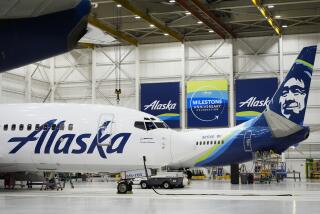Cracks in 747s Prompt Emergency Inspections : Fuselage Damage Could Cause Crash, FAA Says; Boeing Co. Downplays Seriousness of Condition
- Share via
WASHINGTON — Warning that the problem could lead to the crash of a jumbo jet, the government Monday ordered an emergency inspection of Boeing 747s after severe cracks were found in their fuselages, including one instance in which three parts of a fuselage frame were found to be “essentially severed.”
The Federal Aviation Administration, which issued the order, stopped short of grounding the nation’s Boeing 747 commercial air fleet. The Boeing Co. in Seattle and three of the largest airlines that use Boeing 747s said the inspections could be completed without any disruption of domestic or foreign schedules.
Force of Law
Any cracked parts discovered during the inspections must be “repaired or replaced prior to further flight,” the FAA said in its “emergency airworthiness directive,” an order which has the force of law.
Boeing played down the seriousness of the cracks. “We are calling this a ‘non-emergency’ situation,” company spokesman David Jiminez said. Another Boeing spokesman, Jack Gamble, called the cracks “minor little things.” He said they would have no effect on the operation of the aircraft and would not “compromise the integrity of the airframe.”
But C.O. Miller, former chief investigator for the National Transportation Safety Board and one of the nation’s most respected airline safety consultants, told The Times: “You don’t fool around with major cracks in the fuselage. If things start coming unglued like that, then you’ve lost an airplane. It’s that simple.
“You just don’t take chances with cracks in basic fuselage structure.”
The FAA itself noted that, on one of the airplanes with some of the cracks that led to its emergency inspection order, “three adjacent frames were found essentially severed.” Such a failure “could lead to rapid decompression of the fuselage,” the agency said, “and possible loss of the airplane.”
Boeing refused to name the airlines whose cracked planes precipitated the inspection order, saying it might harm customer relations. But Robert Buckhorn, an FAA spokesman, said that the cracks were found in two 747s being flown by Pan American World Airways, one being flown by TWA and one by British Airways.
All of the cracks were discovered during routine maintenance, a Boeing spokesman said. He said all were in the front part of the fuselage.
The three adjacent frames that were “essentially severed” were discovered along part of the fuselage structure called a “stringer,” the FAA said. The agency’s inspection order said that the stringer extends along the side of all 747 fuselages about halfway down, just below the passenger windows and not far behind the nose.
Officially, Boeing attributed the cracks to structural fatigue.
But a company source called it “a geriatric problem” caused in part by aging--and in part by the fact that the 747 fuselage is not round.
Has Flat Sides
“We put the hump on the top of it for an Air Force contract we didn’t get, and that gave it flat sides,” said this source, who asked to remain anonymous. “Flat sides are a pain in the butt. They are a ‘hard part’ in the design that were going to get some cracking. Sure as hell, now they have.
“The flat sides are a design problem that we knew was coming at us.”
The FAA order, which will affect 150 to 160 planes, singles out both flat sides of the fuselage below the passenger windows for scrutiny. It calls for close visual inspection of the fuselage skin between the windows and the cabin floor, beginning seven windows behind the nose.
If the fuselage skin is cracked, the order says, the structural framing beneath the skin should be inspected visually as well.
Must Report Cracks
Any skin or frame cracks must be reported to the FAA within 48 hours of their discovery.
The order calls for 747s that have made more than 14,000 landings to be inspected within 25 flights and planes with 10,000 to 14,000 landings to be inspected within 50 flights. Boeing said this would give airlines from two weeks to 30 days to complete the inspections.
A 747 with 10,000 flights is about 12 years old, a Boeing spokesman said. Those with 14,000 flights are 13 to 14 years old.
Planes with fewer than 10,000 flights or those that have had their fuselage frames visually inspected within the past two years are exempt from the inspection order.
Two years ago, the average age of planes in the 747 fleet was 11.4 years.
Penny Pagano reported from Washington and Richard E. Meyer from Los Angeles.
More to Read
Inside the business of entertainment
The Wide Shot brings you news, analysis and insights on everything from streaming wars to production — and what it all means for the future.
You may occasionally receive promotional content from the Los Angeles Times.










